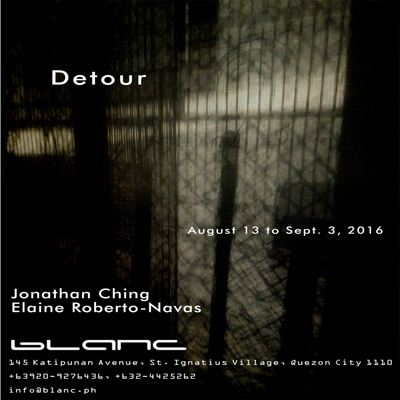
The works of painters Jonathan Ching and Elaine Roberto-Navas share an affinity as dense as the impasto-rendered strokes of their images. Also navigating within the ecology of art in Manila, these generic cialis two artists share instances of participating in shows and projects that map overlapping schools of thought from the later 90’s onwards. It is this very constellation that honored their studio-based practices, whether as an émigré artist like cialis for daily use from canada Singapore-based Navas or one of Ching’s that founded alternative modes such as Surrounded By Water and persisted through the changing fabric of artistic production in Manila. Hence, it is not unlikely that it is from this site that the two artists glean the images of their consciousness from: facades and tricks of perception, infrastructural composites and translations – all springing from the tactility of Manila as a physical and memory location.
The two-person exhibition Detour is originally banked on such affinities, and would propose one strand of studio practice since the 2000s that resisted the flatness through the sensibility of paint as a physical extension of an image. Perhaps there was the tyranny of masterpieces that besieged painting education: what circulated were reproduced images in books and the critical act of the artist is to free the image through the permeating presence of the material used to create the image. Detour speaks about how artists like Ching and Navas confront the image: as familiarity-recognition, a retranslation of memory. Both artists lead us to scenes unseen often through the autopilot of navigating public spaces – scenes that have slipped through the cracks and have emerged in a déjà vu-like mode of overlapping recognitions. As the line from Suzanne Vega’s “Street Legal, Finally” goes: how weird it was to drive streets I knew so well/ what a different perspective, Detour takes from this cue a rupture of familiarity and recollection of existing spaces.
The composite of images that make up the overall fountain-like structure of Ching’s paintings echoes the mingling of readymades in the artist’s visual vocabulary. For context’s sake, these parts take from classical structures that have gained traction on Ching over the years. As a painter who unpicks and revives allegorical insight into European proto-/modernist painters, he retranslates their traditions to understand his position as one that confronts the history of painting. The details of this suite of paintings for Detour unpicks his attention on classical sculptures: from the 17th century Manneken Pis in Brussels to the 18th Century initiative of the Carriedo Fountain in Sta. Cruz, Manila. The manner in which Ching isolates sections of these structures and arranges them as composites reveals the mode through which time reconfigures the knowledge often incongruous to such direct encounter. Memory extends past the idea that images are a puzzle to be held against the present reality of the subjects of our consciousness. Rather, memory also accommodates what seems familiar but is remembered to not have been experienced at all.
There is a continuum to the series of façade subjects Navas connects to in Detour. The appearance of the gates and entry facades made its way into her body of works in 2013, where she painted them to scale. Her return to her attraction to the wear of time in these fixtures in urban landscapes was beckoned by the photographic works of Sam Kiyoumarsi – whose aesthetic draws up poignant nuances of street scenes. In Navas’s conversation with his images, she traverses the diametric of painterly photographs and paintings what is the side effect of cialis pills translated from the photographic image. The grit and glut of such white elephants in the city that Kiyoumarsi sharply acknowledges revived Navas’s sense of viagraonlinepharmacy-best relevance to such structures that demanded against any form of intrusion. What seemed midwestern university pharmacy to have been exhausted has been recalled to be looked at again: a landscape lulled to sleep by the wear of time is roused to wakefulness through an artist’s mindfulness.
Ching and Navas walk us through streets that are real and familiar in Detour. There is a remembrance of such physical and memory sites despite our actual non-encounter of them. We are not sure how we recognize these places through the spaces between dense strokes, for hints at such context become irrelevant as the tactility of Ching’s and Navas’s images abstract themselves.
Sidd Perez, 2016.


























